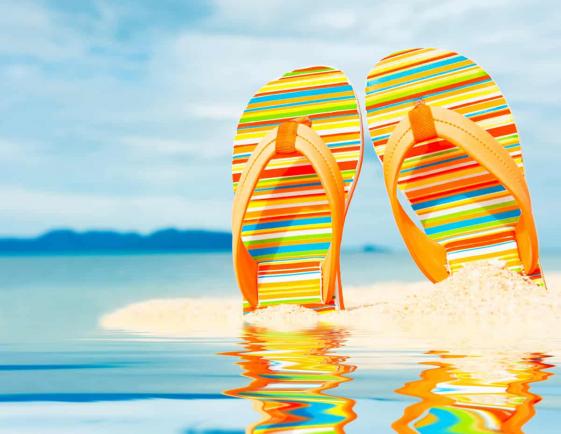
When it comes to summer, kids have no boundaries. They will run and play hard on the hottest of days and never give it a second thought. That's why we have to be aware of how much heat is too much and what to do to protect them.
First off, it is vital to recognize the symptoms of heat-induced illness.
Heat exhaustion
Comes easily to little ones who are full of energy in higher temperatures. Symptoms to watch out for include thirst, fatigue, leg or stomach cramps, and cool, moist skin.
Heat exhaustion is simply treated. Remove the child from the sun and cool them off. Make certain they are well-hydrated with water and not sugary or caffeinated drinks. Nothing too cold to drink, as it may induce cramps. Put them in a cool bath and hold a cold, wet rag to the back of their neck, which is a pulse point and immediately cools the body down. Have them lie down with a quiet movie or activity and let them rest.
When it goes beyond heat exhaustion into heat stroke, we have to take immediate action. This is a condition that can be critical and even fatal if not treated.
According to BabyCenter.com, if your child's heat exhaustion progresses to heat stroke, he may have any of the following symptoms:
-
A temperature of 103 degrees Fahrenheit (39.4 degrees Celsius) or higher - but no sweating
-
Hot, red, dry skin
-
Rapid pulse
-
Restlessness
-
Confusion
-
Dizziness
-
Headache
-
Vomiting
-
Rapid, shallow breathing
-
Lethargy (Your child might not respond as strongly as usual when you call his name or tickle his skin, for example.)
-
Unconsciousness
If you suspect heat stroke, err on the side of caution. A child suffering from heat stroke can easily and quickly slip into unconsciousness. The child's temperature must be lowered as quickly as possible without causing him to go into shock. Here is the immediate action to take:
Call 911
The child with these symptoms needs to be seen quickly. The reason for calling 911 rather than driving your child to the hospital is that there are tasks you need to do to relieve your child while waiting for help to arrive.
Comfort child
Throughout this process, speak softly and don't show anxiousness or fear. Comfort your child by singing a soft song or encouraging them.
Move to a cool place
If you are outdoors, find shade. If you are indoors, go to the coolest room.
Remove clothing
Strip the child down. If they are modest or shy, strip down to their undies.
Lie them down
Have your child lie down but put a small pillow or rolled up towel under their head. Keep them as still as possible.
Fan them
If you are indoors and have a window or other fan, let the cool air blow on them. If you are outdoors, use your hand or a magazine - whatever you have that will move the most air over them.
Gently bathe them
Not in a tub, but with a rag and a basin of cool (not cold) water. Soak the cloth and squeeze the water out over their body, particularly on pulse points (back of neck and wrists), but also on head, chest, back and extremities.
Don't give them ibuprofen or Tylenol
Though you might be tempted to administer a fever reducer, it will not work on heat stroke.
Do not give them anything to eat or drink
Again, you might feel like you should give them water to drink or pull out a Popsicle, but at this point it is not wise.
Now that I've given you the scary news, here's the good news. Heat stroke is easily preventable. Here's what you can do to keep your child safe:
Acclimate
If you know your child is involved in outdoor sports on hot days, spend two weeks before getting them acclimated to the heat. Let them go out and play for small periods of time, increasing the time by a little each day.
Plan for your days
On days where there aren't any planned activities, schedule in frequent breaks and encourage them to drink lots of water. Plan quiet times indoors during peak hours of extreme heat.
Clothing
Have your child wear loose-fitting clothing, in light colors, if possible, and remember that natural fibers (cotton/linen) breathe better than manmade cloth. Being covered in something lightweight and loose is better than tight halters and spandex shorts.
Hydrate
Avoid sodas and other sugary drinks, including too much juice. Stay away from caffeinated beverages such as colas and iced tea, which actually dehydrate. Water is the best drink to give them. Keep a jug filled in the fridge for them.
Body coolers
As a family craft, gather up bandanas and go to the craft store and buy water-absorbing crystals. Make a tube out of the bandana, leaving the ends open. Fill tube with crystals (about 1/4 c. per) and sew shut. When working or playing outdoors, soak in water and tie around your neck. This is a great craft project for kids to do and will significantly reduce the heat for them.
An ounce of prevention is worth a pound of cure. Keep your kids safe this summer by frequently monitoring them for heat sickness. Teach them the signs so that they can learn to be responsible for their own health. Summer is for fun, not hospital visits. Here are some great ideas for summer games. These can be played at night to avoid the dangerous heat of the summer day.

